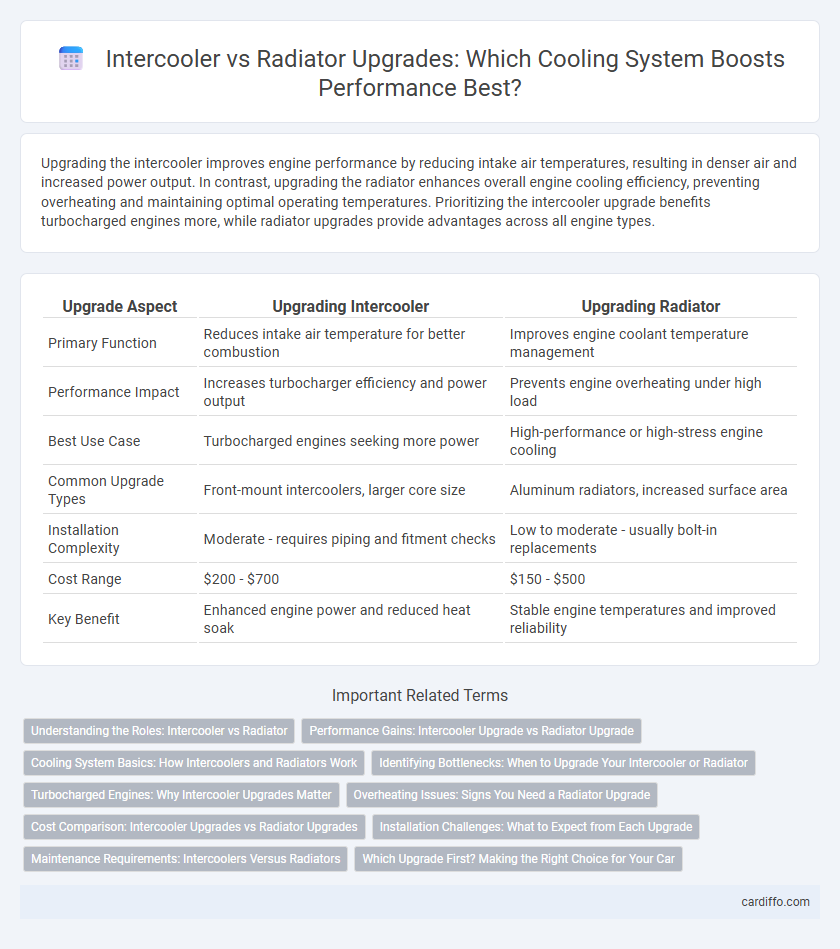Upgrading the intercooler improves engine performance by reducing intake air temperatures, resulting in denser air and increased power output. In contrast, upgrading the radiator enhances overall engine cooling efficiency, preventing overheating and maintaining optimal operating temperatures. Prioritizing the intercooler upgrade benefits turbocharged engines more, while radiator upgrades provide advantages across all engine types.
Table of Comparison
| Upgrade Aspect | Upgrading Intercooler | Upgrading Radiator |
|---|---|---|
| Primary Function | Reduces intake air temperature for better combustion | Improves engine coolant temperature management |
| Performance Impact | Increases turbocharger efficiency and power output | Prevents engine overheating under high load |
| Best Use Case | Turbocharged engines seeking more power | High-performance or high-stress engine cooling |
| Common Upgrade Types | Front-mount intercoolers, larger core size | Aluminum radiators, increased surface area |
| Installation Complexity | Moderate - requires piping and fitment checks | Low to moderate - usually bolt-in replacements |
| Cost Range | $200 - $700 | $150 - $500 |
| Key Benefit | Enhanced engine power and reduced heat soak | Stable engine temperatures and improved reliability |
Understanding the Roles: Intercooler vs Radiator
Upgrading an intercooler enhances the efficiency of cooling compressed air from the turbocharger, directly improving engine performance and reducing intake air temperatures for better combustion. In contrast, upgrading the radiator focuses on dissipating heat from the engine coolant, maintaining optimal engine temperature and preventing overheating during extended or high-stress driving. Understanding these distinct cooling roles helps in selecting the right upgrade to support specific performance and reliability goals.
Performance Gains: Intercooler Upgrade vs Radiator Upgrade
Upgrading an intercooler significantly enhances engine performance by reducing intake air temperatures, resulting in denser air charge and increased power output, especially in forced induction engines. A radiator upgrade primarily improves cooling system efficiency, preventing overheating during high-performance or prolonged driving but has a less direct impact on horsepower compared to an intercooler. For maximizing performance gains, an intercooler upgrade offers more noticeable improvements in throttle response and engine power, whereas a radiator upgrade ensures sustained engine reliability under thermal stress.
Cooling System Basics: How Intercoolers and Radiators Work
Upgrading the intercooler enhances the engine's intake air temperature by improving heat exchange between compressed air and ambient air, crucial for turbocharged engines to increase power output and prevent detonation. In contrast, upgrading the radiator focuses on maintaining optimal engine coolant temperatures by dissipating heat from the engine block, preventing overheating during prolonged operation or intense driving conditions. Understanding the distinct roles of intercoolers in air cooling and radiators in liquid cooling is essential for targeted performance cooling system upgrades.
Identifying Bottlenecks: When to Upgrade Your Intercooler or Radiator
Upgrading your intercooler or radiator depends on pinpointing the primary heat management bottleneck in your engine system. If intake air temperatures remain high under boost, indicating inadequate charge cooling, an intercooler upgrade is essential to prevent heat soak and maintain performance. Conversely, if coolant temperatures spike during extended operation or heavy loads, upgrading the radiator improves heat dissipation and prevents engine overheating.
Turbocharged Engines: Why Intercooler Upgrades Matter
Upgrading the intercooler on turbocharged engines significantly enhances air cooling efficiency, reducing intake temperatures and increasing air density for improved combustion. This results in higher power output and better engine reliability under high boost conditions compared to just upgrading the radiator, which primarily manages engine coolant temperature. Intercooler upgrades directly address heat management in forced induction systems, making them essential for maximizing turbocharged engine performance.
Overheating Issues: Signs You Need a Radiator Upgrade
Persistent engine overheating, frequent coolant loss, or visible coolant leaks are clear signs you need a radiator upgrade rather than just an intercooler enhancement. A radiator upgrade improves heat dissipation for efficient engine temperature control, addressing overheating issues more directly than an intercooler, which primarily cools intake air. Ensuring optimal radiator performance helps prevent severe engine damage caused by excessive heat buildup during high-demand driving conditions.
Cost Comparison: Intercooler Upgrades vs Radiator Upgrades
Intercooler upgrades typically cost between $300 and $900 depending on size and brand, offering efficient cooling for turbocharged engines, while radiator upgrades range from $250 to $700, providing essential temperature regulation for all engine types. Intercoolers often require more specialized installation and maintenance compared to radiators, potentially increasing total upgrade expenses. Choosing between the two depends on vehicle requirements and budget, with intercoolers generally favored for performance gains in forced induction systems despite higher costs.
Installation Challenges: What to Expect from Each Upgrade
Upgrading the intercooler requires precise fitting within the limited engine bay space, often necessitating modifications to existing brackets and hoses to ensure optimal airflow and cooling efficiency. Upgrading the radiator typically involves dealing with larger dimensions and additional clearance for the expanded core, which may require removing or adjusting nearby components like the fan shroud or bumper supports. Both upgrades demand careful attention to compatibility with the vehicle's cooling system to avoid leaks or overheating but the radiator upgrade often involves more extensive disassembly and reassembly processes.
Maintenance Requirements: Intercoolers Versus Radiators
Upgrading an intercooler typically demands less frequent maintenance than radiator upgrades due to its simpler design and fewer moving parts, resulting in less susceptibility to leaks and clogging. Radiators require regular flushing and coolant replacement to prevent corrosion and overheating, making their upkeep more intensive and time-sensitive. Choosing between the two upgrades depends on balancing performance improvements with the manageable maintenance schedules of intercoolers versus the critical cooling system care radiators need.
Which Upgrade First? Making the Right Choice for Your Car
Upgrading the intercooler first enhances engine performance by lowering intake air temperature, crucial for turbocharged engines seeking increased power and efficiency. Upgrading the radiator primarily improves cooling system capacity, preventing engine overheating under sustained high loads or extreme driving conditions. Prioritize the intercooler upgrade if boosting performance is the goal, but choose the radiator upgrade first when addressing overheating or reliability concerns.
Upgrading intercooler vs upgrading radiator Infographic

 cardiffo.com
cardiffo.com